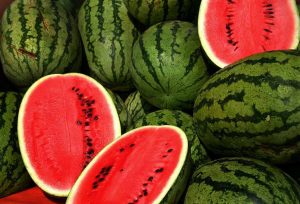All You Need To Plant Watermelon Successfully
Watermelon , botanically known as Citrullus lanatus , is one of the world most consumed fruits. Health wise, it is very valuable by the virtue of the nutrient and mineral one derives from it.
Also its market value is unfathomable especially during the dry season.
Water melon is a tropical plant, which requires a lot of sunlight and water for its growth and development. Below are all you need to plant and have a good yield.

Type of soil to plant watermelon
Water melon requires a well drained, deep and friable soil also with rich in organic matters. Water melon does not grow well on a water-logged soil as this can cause the emergence of fungal diseases but the soil must be wet.
Weather condition that favours water melon
Watermelon requires a lot of sunlight, the dry season is the best season to plant water melon. In cooler climate condition, it requires about three months of constant hot, sunny weather to grow and ripen well. Watermelon grows in full sun, abundant supply of water and nutrient is also essential.
Land preparation for planting watermelon
Conventional tillage practise is needed to enable good root development and also absorption of water. The land should be ploughed and harrowed to make it suitable for the planting condition. A long ridge or mould of 6 feets by 6 feets can be made or planting directly into the soil. Organic manure, such as poultry waste can be incorporated to the soil to make the soil rich in essential nutrients that enhance the growth of the plant.
Planting watermelon seeds
Watermelon seeds can be planted at a rate of 2-3 seeds per hole and the most vigorous stand is left on the field while the weak and unthrifty one is eliminated. The depth of the hole is about 1.5cm and the spacing 6 feets by 6 feets, watermelon needs a lot of space as well.
Germination
Watermelon germinates quickly, the leaves appear at about 3 days after sowing.
Management practices of watermelon after germination.
Watermelon requires a lot of care starting from the day of emergence to harvesting. These include;
Watering: water melon should be watered daily until fruit develops. In a commercial level, a drip irrigation system can be installed to regularly supply the plant with water. Apply water at least once a day.
Mulching: this is done in order to conserve moisture and control weeds, this can be done with straws or polythene nylon or black plastic.
Fertilizer Application: Nitrogenous fertilizer is needed at the early stage of this plant but when fruit develops, phosphorus and potassium based fertilizer is needed mostly as these will enhance the growth and development of the fruit. Apply NPK 15:15:15 after 10 days of planting and SSP and NPK at about 40 days after planting.
Weeding: weeding should be done before the application of fertilizer to discourage competition among the plant and the weeds, this should be done every two weeks.
Pest and disease control: Just like all plants, watermelon has insects and pests that do attack it, however several measures has been suggested to tackle this threat. Laraforce and cyberfore can be used every month to be on the more safer side.The main threat of watermelon is a mildew, this is a fungus disease. The leaves appear as if there is whitish powder on it, it best thrives in damp and humid environment this is why the farm must not be damp.
Sweetening of watermelon: The taste of watermelon can be improved by not applying water at about 10 days before harvesting, this will make the melon sweeter.
Harvesting
Watermelon matures at about 80- 90 days of planting. Ensure ripening watermelons are not in direct contact with the soil to prevent rot and protect fruit from pest and rodents, as the size of the fruit increases, place it on a bed of straw or other mulching material. There are three approaches to know when the watermelon fruit is ripe or not;
The first sign is that the curly tendril at the stem tends to dry up, once it has totally dried up, then the fruit may be said to be ripe.
Another sign is that the light coloured patched at the bottom of the fruit, it is normally green but when the fruit ripens the green colour disappears and it becomes yellowish.
The most popular way is thumbing the fruit, if it makes a higher pitched sound, it means the fruit is unripe but if it makes a dull , hollow sound it means the fruit is ripe.


